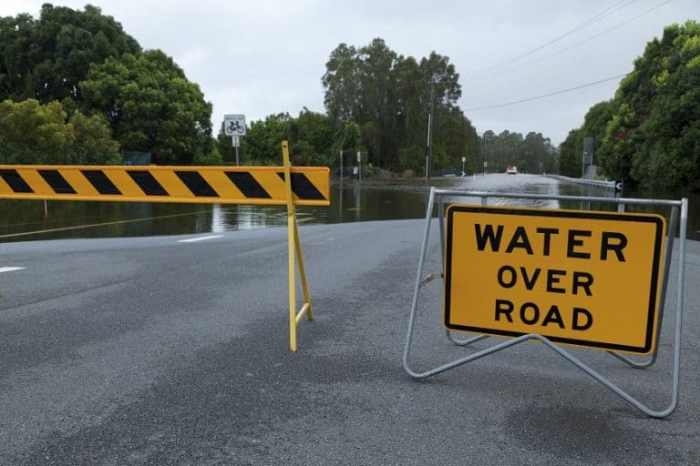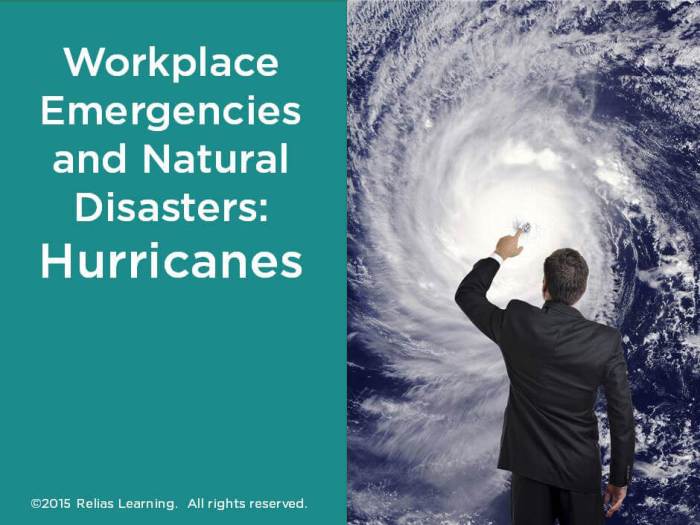Natural disasters and workplace emergencies an overview – Natural disasters and workplace emergencies pose significant threats to businesses and employees alike. Understanding the types of natural disasters, developing effective emergency plans, and implementing risk mitigation strategies are crucial for ensuring workplace safety and minimizing disruptions during emergencies.
Natural Disasters: Types and Impacts
Natural disasters pose significant threats to workplaces, causing disruptions, damage, and even loss of life. Understanding the different types of natural disasters and their potential consequences is crucial for effective emergency planning and response.
Common types of natural disasters include earthquakes, hurricanes, floods, wildfires, and tornadoes. Each type of disaster has unique characteristics and can have devastating effects on businesses.
Earthquakes can cause severe structural damage, leading to building collapses and injuries. Hurricanes bring high winds, heavy rainfall, and storm surges, which can cause flooding, power outages, and transportation disruptions.
Floods can inundate buildings, damage equipment, and disrupt operations. Wildfires spread rapidly, consuming vegetation, structures, and air quality.
Tornadoes are characterized by high-speed winds that can cause severe damage to buildings, infrastructure, and vegetation.
Historical natural disasters have had significant impacts on businesses. The 1994 Northridge earthquake in California caused billions of dollars in damage and disrupted operations for many companies.
The 2005 Hurricane Katrina devastated the Gulf Coast, causing widespread flooding and damage to infrastructure and businesses.
Organizations face numerous challenges in preparing for and responding to natural disasters. These include:
- Predicting the timing and severity of disasters
- Developing comprehensive emergency plans
- Training employees on emergency procedures
- Acquiring necessary resources and equipment
- Coordinating with external agencies
Workplace Emergencies: Planning and Response
Effective workplace emergency planning is essential to ensure the safety of employees and minimize business disruptions. A comprehensive plan should include the following key elements:
- Identification of potential hazards and risks
- Establishment of emergency response procedures
- Designation of emergency roles and responsibilities
- Training and drills for employees
- Communication and coordination protocols
- Evacuation plans and routes
- First aid and medical response procedures
- Business continuity and recovery plans
Employees and management play critical roles in emergency situations. Employees should be familiar with emergency procedures and know their responsibilities.
Management is responsible for developing and implementing the emergency plan, providing necessary resources, and coordinating the response.
Clear communication and coordination are vital during emergencies. Establishing communication channels and protocols ensures that employees can receive timely information and instructions.
Risk Assessment and Mitigation Strategies

Conducting a workplace risk assessment is crucial for identifying and prioritizing potential hazards and risks associated with natural disasters.
The risk assessment should consider factors such as the location of the workplace, historical disaster data, and the types of natural disasters that are likely to occur in the area.
Based on the risk assessment, organizations can implement various mitigation strategies to reduce the risk of workplace emergencies. These strategies may include:
- Building codes and structural reinforcements
- Flood barriers and drainage systems
- Fire suppression and detection systems
- Landscaping and vegetation management
- Business continuity and disaster recovery plans
Successful risk mitigation measures have been implemented in real-world settings. For example, the use of seismic base isolation systems in buildings has significantly reduced the risk of damage during earthquakes.
Employee Training and Awareness

Employee training and awareness programs are essential for preparing workplaces for emergencies. Training should cover topics such as:
- Emergency procedures and evacuation routes
- First aid and medical response
- Communication and coordination protocols
- Business continuity and recovery plans
Different types of training programs can be implemented, including classroom training, online modules, and hands-on drills.
Best practices for conducting effective employee training sessions include:
- Tailoring training to specific job roles and responsibilities
- Using a variety of training methods
- Involving employees in the development and delivery of training
- Regularly updating and refreshing training
Legal and Regulatory Compliance: Natural Disasters And Workplace Emergencies An Overview

Organizations are subject to legal and regulatory requirements for workplace emergency preparedness and response. These requirements vary depending on the jurisdiction.
Common requirements include:
- Developing and implementing an emergency plan
- Providing employee training
- Conducting risk assessments
- Reporting incidents and emergencies
Non-compliance with legal and regulatory requirements can result in fines, penalties, and legal liability.
Organizations can ensure compliance by:
- Reviewing applicable laws and regulations
- Developing and implementing comprehensive emergency plans
- Providing regular employee training
- Maintaining accurate records and documentation
- Working with legal and regulatory authorities
Technology and Innovation in Emergency Management
Technology plays a significant role in improving workplace emergency preparedness and response. Different types of technology can be used for emergency management, including:
- Early warning systems
- Communication and coordination tools
- Location tracking and mapping systems
- Data analytics and predictive modeling
- Artificial intelligence and machine learning
Innovative technologies have been implemented in real-world settings to enhance emergency management. For example, early warning systems have been used to provide timely alerts and evacuation notices.
Key Questions Answered
What are the most common types of natural disasters that affect workplaces?
Earthquakes, hurricanes, floods, wildfires, and tornadoes are among the most prevalent natural disasters that pose risks to workplaces.
What are the key elements of an effective workplace emergency plan?
Evacuation procedures, communication protocols, designated safe zones, and employee training are essential components of a comprehensive emergency plan.
How can technology enhance workplace emergency preparedness?
Early warning systems, real-time communication tools, and data analytics can significantly improve emergency response coordination and decision-making.